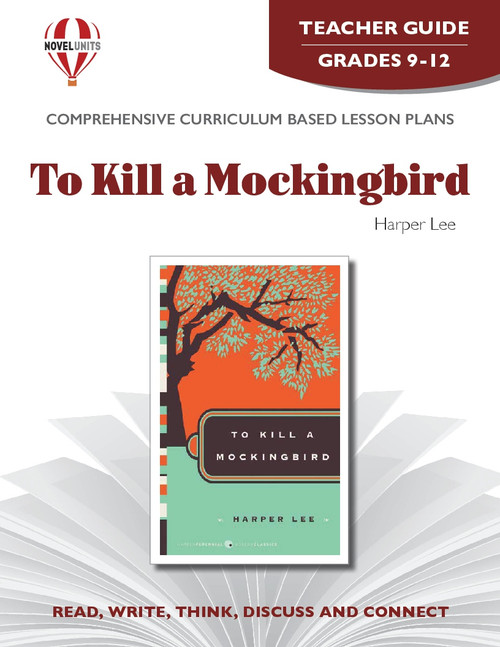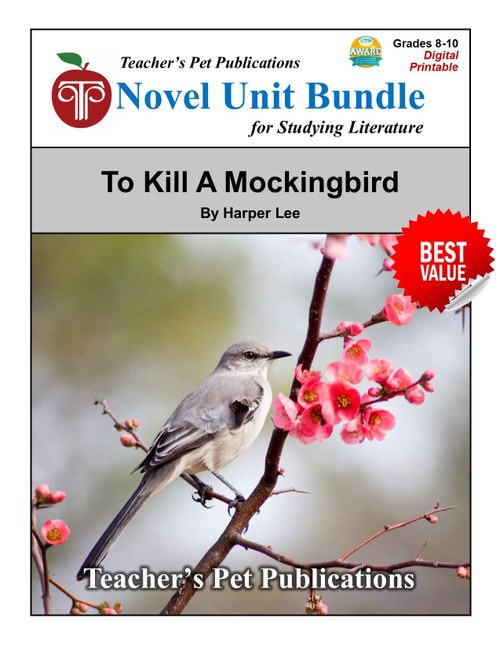Product Overview
To Kill A Mockingbird: Courage and Conscience in the Heart of Maycomb
A powerful exploration of racial injustice, moral growth, and empathy, which provides critical lessons in understanding and addressing societal issues.
Ordering Books for To Kill a Mockingbird by Harper Lee
No order minimum; you can order just one copy if that's all you need! :-) Order your class set of books for To Kill a Mockingbird now, and take advantage of our bulk order discounts!
About the Book To Kill a Mockingbird
|
Harper Lee's novel shed light on the issue of racism in the American South during the 1930s. It still challenges readers to confront their own biases and prejudices and to have more empathy and compassion for others. To Kill a Mockingbird is set in the sleepy town of Maycomb, Alabama, during the Great Depression. The story is narrated by Scout Finch, a young girl who lives with her older brother Jem and their widowed father, Atticus Finch. Atticus is a lawyer who is highly respected in the community for his integrity and wisdom. The novel begins with Scout and Jem's adventures and their fascination with the mysterious Boo Radley, a reclusive neighbor. Over time, they learn more about the complexities of the adult world, particularly through Atticus's work. The central event of the novel is the trial of Tom Robinson, a black man falsely accused of raping a white woman, Mayella Ewell. Atticus defends Tom, but despite his compelling evidence of Tom's innocence, the jury convicts Tom due to racial prejudice. The trial and its aftermath profoundly impact the Finch family and the community, revealing deep-seated racism and injustice. In the end, Jem and Scout come to understand the courage and moral strength of their father. That courage and moral strength from people like Atticus and Scout would become the backbone of the continuation of the Civil Rights Movement, leaving the book ending on a hopeful note. To Kill a Mockingbird won the Pulitzer Prize
|
Themes in the book To Kill a Mockingbird |
The Destructive Power of Prejudice: Perhaps the most significant theme of To Kill a Mockingbird is the destructive power of prejudice. Throughout the novel, we see how racial and social biases can lead to injustice and harm individuals and communities. From Tom Robinson's trial to the treatment of Boo Radley, Lee exposes the damaging effects of discrimination on both victims and perpetrators. Coming-of-Age: Another prominent theme in the novel is coming-of-age. Through Scout's narration, we witness her growth and development as she learns about the world around her. She begins to question societal norms and expectations, particularly regarding gender roles and race. This process of self-discovery is also evident in Jem's character as he grapples with the harsh realities of racism in their town. The Moral Nature of Human Beings: One of the central themes of To Kill a Mockingbird is the moral nature of human beings. Atticus teaches Scout and Jem that people have both good and bad qualities and that it is essential to understand and empathize with others. This theme is encapsulated in Atticus's advice to Scout, "You never really understand a person until you consider things from his point of view." The Importance of Moral Education: The novel also emphasizes the importance of moral education. Through their experiences, Scout and Jem learn about courage, empathy, and justice. Atticus serves as a moral beacon, guiding them to make ethical choices even when it's difficult or unpopular. Racism and Social Injustice: Racism and social injustice are pervasive themes in the novel. The trial of Tom Robinson highlights the systemic racism that affected the legal system and society at large. The novel also explores the impact of these injustices on individuals and communities, prompting readers to reflect on their own beliefs and actions. Courage: Atticus's unwavering courage in defending Tom Robinson despite facing backlash from his community highlights the theme of bravery. Atticus consistently stands up for what is right, even when it means going against popular opinion. His actions inspire Scout and Jem to also find their own sources of courage, whether it be standing up to bullies or speaking out against injustice. The Importance of Empathy: Along with courage, empathy is crucial in the novel. Through the characters of Atticus and Boo Radley, Lee shows us the power of understanding and compassion towards others. Atticus's ability to see things from others' perspectives allows him to be a fair and just individual, while Boo's empathetic actions ultimately save Scout and Jem's lives.
|
Activity Ideas for the book To Kill a Mockingbird |
Mock Trial: Conducting a mock trial based on the events of Tom Robinson's case can be a powerful way to explore themes of justice and morality. Assign students roles as lawyers, witnesses, and jurors. This activity encourages students to think critically about the legal system and the concept of fairness. Character Analysis Essays: Have students write character analysis essays focusing on key figures like Atticus Finch, Scout, and Tom Robinson. Guide them to explore the characters' complexities, motivations, and growth throughout the novel. This exercise fosters analytical skills and a deeper appreciation for Harper Lee's storytelling. Historical Context Research: Understanding the historical context of the 1930s is crucial for grasping the novel's themes. Assign students research projects on the Great Depression, Jim Crow laws, and the Civil Rights Movement. Presenting their findings helps students connect the novel to real-world events and deepen their understanding of its social and political implications. Book Discussions and Literature Circles: Organize literature circles where students can discuss specific chapters or themes in smaller groups. Providing guiding questions and rotating discussion leaders ensures that everyone participates and contributes. This format promotes active engagement and collaborative learning.
|

Customer Service
- We guarantee you'll have the best customer service experience ever with Teacher's Pet Publications.
- We are here to help make things as easy as possible for you!
- Your information is secure. We don't keep your card number on file anywhere, and we don't sell, rent, or give away your personal information.
- We treat you as we would like to be treated as a customer!
- Need help? Have questions? We're always happy to assist you! Contact Us











